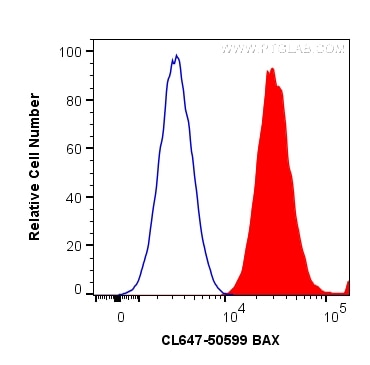- Featured Product
- KD/KO Validated
BAX Polyklonaler Antikörper
BAX Polyklonal Antikörper für FC (Intra)
Wirt / Isotyp
Kaninchen / IgG
Getestete Reaktivität
human, Maus, Ratte
Anwendung
FC (Intra)
Konjugation
CoraLite® Plus 647 Fluorescent Dye
Kat-Nr. : CL647-50599
Synonyme
Galerie der Validierungsdaten
Geprüfte Anwendungen
| Erfolgreiche Detektion in FC | HeLa-Zellen |
Empfohlene Verdünnung
| Anwendung | Verdünnung |
|---|---|
| Sample-dependent, check data in validation data gallery | |
Produktinformation
CL647-50599 bindet in FC (Intra) BAX und zeigt Reaktivität mit human, Maus, Ratten
| Getestete Reaktivität | human, Maus, Ratte |
| Wirt / Isotyp | Kaninchen / IgG |
| Klonalität | Polyklonal |
| Typ | Antikörper |
| Immunogen | BAX fusion protein Ag0576 |
| Vollständiger Name | BCL2-associated X protein |
| Berechnetes Molekulargewicht | 21 kDa |
| Beobachtetes Molekulargewicht | 21 kDa |
| GenBank-Zugangsnummer | BC014175 |
| Gene symbol | BAX |
| Gene ID (NCBI) | 581 |
| Konjugation | CoraLite® Plus 647 Fluorescent Dye |
| Excitation/Emission maxima wavelengths | 654 nm / 674 nm |
| Form | Liquid |
| Reinigungsmethode | Antigen-Affinitätsreinigung |
| Lagerungspuffer | BS mit 50% Glyzerin, 0,05% Proclin300, 0,5% BSA, pH 7,3. |
| Lagerungsbedingungen | Bei -20°C lagern. Vor Licht schützen. Nach dem Versand ein Jahr stabil. Aliquotieren ist bei -20oC Lagerung nicht notwendig. 20ul Größen enthalten 0,1% BSA. |
Hintergrundinformationen
BAX (also known as BCL2 Associated X, Bcl-2-Like Protein 4, Bcl2-L-4, BCL2L4) is a member of the BCL2 family of proteins that play a key role in the regulation of apoptosis in higher eukaryotes (https://www.uniprot.org/uniprot/Q07812). BAX comprises 4 Bcl-2 homology domains (BH1-BH4) and a C-terminal transmembrane domain. In healthy mammalian cells, BAX is localized to the cytoplasm through its interaction with the anti-apoptotic BL-2 family members BCL2L1/Bcl-xL (PMIDs: 28755482, 21458670). In response to apoptotic stimuli, however, BAX undergoes a conformational change that causes it to translocate to the outer mitochondrial membrane where it initiates the mitochondrial pathway of apoptosis via two potential mechanisms. Firstly, upon translocation to the outer mitochondrial membrane, BAX interacts with the mitochondrial voltage-dependent anion channel (VDAC) leading to the opening of the channel, loss of membrane potential, and the release of cytochrome c from the mitochondrion (PMID:10766872). The release of cytochrome C into the cytoplasm leads to the activation of Caspase3, initiating apoptosis. Secondly, activated BAX forms homodimers, which then assemble into oligomers on the mitochondrial outer membrane to create pores that permeabilize the mitochondrion leading to the release of cytochrome C (PMID:25458844).
BAX has been shown to be involved in p53-mediated apoptosis. Expression of the human bax gene has been shown to be directly regulated by p53, and the bax promoter contains four motifs with homology to consensus p53-binding sites (PMID:7834749). Furthermore, p53 directly interacts with BAX to promote its activation (PMID:14963330).
What is the molecular weight of BAX?
BAX is a 192 amino acid protein that has a predicted molecular weight of 21.1 kDa.
What is the subcellular localization of BAX?
In healthy mammalian cells, BAX is localized to the cytoplasm. In response to apoptotic stimuli, BAX translocates to the outer mitochondrial membrane.
What is the tissue specificity of BAX?
BAX is ubiquitously expressed (PMID: 25613900).
What is the connection between BAX and cancer?
BAX appears to play an important role in suppressing cancer development, and decreased BAX levels are associated with chemo- and radioresistance in a number of cancers including lung cancer, chronic lymphocytic leukemia (CLL), and prostate cancer. Loss-of-function mutations of BAX have also been reported in hematopoietic malignancies in humans (PMID:9531611) and in gastrointestinal cancer of the microsatellite mutator phenotype (MMP), where BAX inactivation contributes to tumor progression by providing a survival advantage (PMID:9331106).
A number of anticancer drugs used clinically have been demonstrated to induce BAX activation indirectly to facilitate apoptosis of tumor cells. Recent efforts have demonstrated that BAX itself may be a promising direct target for small-molecule drug discovery for novel anticancer drugs and several direct BAX activators have been identified that may hold promise for cancer therapy, with the potential to overcome chemo- and radioresistance (PMID:25230299).
Protokolle
| Produktspezifische Protokolle | |
|---|---|
| FC protocol for CL Plus 647 BAX antibody CL647-50599 | Protokoll herunterladen |
| Standard-Protokolle | |
|---|---|
| Klicken Sie hier, um unsere Standardprotokolle anzuzeigen |


